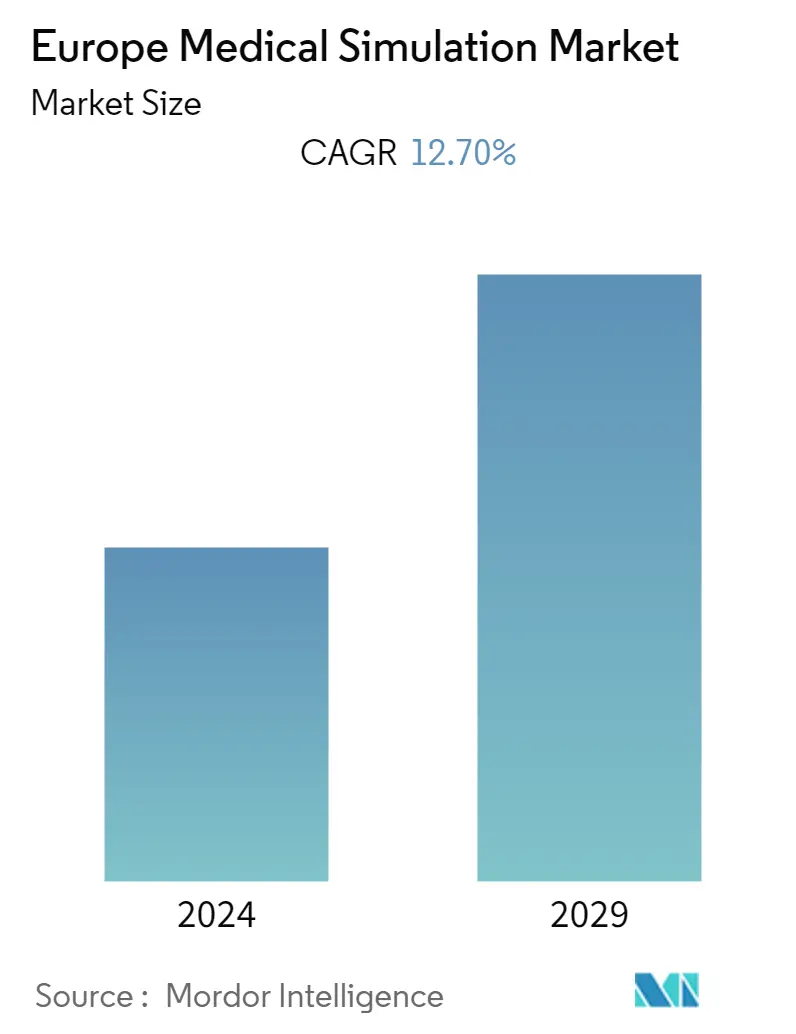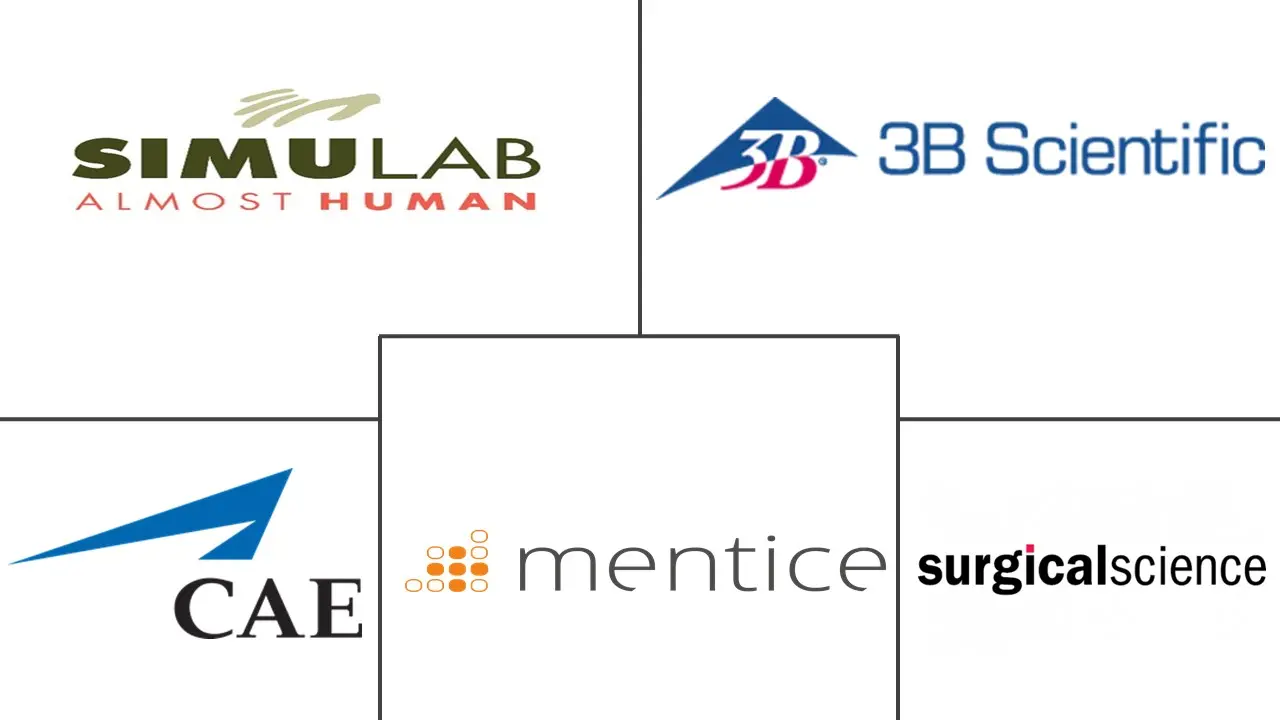Market Size of Europe Medical Simulation Industry

| Study Period | 2019 - 2029 |
| Base Year For Estimation | 2023 |
| Forecast Data Period | 2024 - 2029 |
| Historical Data Period | 2019 - 2022 |
| CAGR | 12.70 % |
| Market Concentration | High |
Major Players
*Disclaimer: Major Players sorted in no particular order |
Europe Medical Simulation Market Analysis
The Europe Medical Stimulation market is expected to register a CAGR of 12.7% over the forecast period.
The outbreak of the COVID-19 pandemic has pushed the medical device industry into action, with a race to develop both therapeutic and preventive devices. Exponentially increasing cases of the coronavirus worldwide are leading to the need for the development of novel treatments, with several clinical trials underway. Meanwhile, the manufacturers of medical devices were highly focused on developing vaccines and drugs, which can also be applied in the diagnosis and treatment of COVID-19, increasing the rate of clinical trials to a great extent. During COVID-19 many companies in Europe have taken initiatives to continue the education of medical stimulation without any disruption. For instance, during the pandemic, VirtaMed initiated numerous tours to support continued medical stimulation education and arranged workshops for residents across Switzerland, France, and Germany. The company also launched a new way of supplying medical training with the latest healthcare simulation solutions in 2020. It was also Switzerland's first mobile surgical simulation lab to deliver risk-free training to the doors of university hospitals and toured for three months. The mobile surgical simulation lab was equipped with the latest mixed reality simulators and has traveled over 2,000 kilometers around Switzerland. The laboratory also visited a total of 16 Swiss university hospitals as well. Therefore, such instances indicate that the market witnessed a considerable growth during the pandemic.
The continuous technological advancements, increasing concerns over patient safety, and increasing demand for minimally invasive treatments are the major drivers for the market growth. For instance, as per the report of Global Obesity Observatory 2021, 24.5% men were obese and 43.8% were overweight in Germany in 2020. Therefore, owing to such percentages the National Obesity Risk predicted was 7/10 which was much higher and an issue of concern for Germany in 2021. Thus, such a scenario has increased the awareness about obesity in Germany owing to which majority of the people are opting for minimally invasive aesthetic surgeries for weight loss. This factor is fueling the demand for aesthetic devices across the country. The use of stimulation techniques in minimally invasive surgeies improves the patient safety thus, majority of the surgeons are utilizing such techniques in minimally invasive surgeries. Therefore, such factors are anticipated to propel the market growth over the forecast period.
However, high cost of simulators and reluctant to adopt new training methods are likely to hinder the market growth over the forecast period.
Europe Medical Simulation Industry Segmentation
As per the scope of the report, medical simulation is the modern-day methodology for training healthcare professionals through the use of advanced educational technology. Medical simulation is experiential learning that every healthcare professional may need, but cannot be always engaged in during real-life patient care. The Europe Medical Simulation Market is segmented by Products (Interventional/Surgical Simulators, Task Trainers, and Other Products), Services and Software (Web-based Simulation, Medical Simulation Software, Simulation Training Services, and Other Services and Software), End Users (Academic and Research Institutes and Hospitals), Technology (High-fidelity Simulators, Medium-fidelity Simulators, and Low-fidelity Simulators), and Geography (Germany, United Kingdom, France, Italy, Spain, and Rest of Europe). The report offers the value (in USD million) for the above segments.
| By Product | |||||||
| |||||||
| Task Trainers | |||||||
| Other Products |
| By Services and Software | |
| Web-based Simulation | |
| Medical Simulation Software | |
| Simulation Training Services | |
| Other Services and Software |
| By End User | |
| Academic and Reseach Institutes | |
| Hospitals |
| By Technology | |
| High-fidelity Simulators | |
| Medium-fidelity Simulators | |
| Low-fidelity Simulators |
| Geography | |
| Germany | |
| United Kingdom | |
| France | |
| Italy | |
| Spain | |
| Rest of Europe |
Europe Medical Simulation Market Size Summary
The Europe medical simulation market is poised for significant growth, driven by technological advancements, heightened patient safety concerns, and the increasing demand for minimally invasive treatments. The COVID-19 pandemic acted as a catalyst, accelerating the development and adoption of medical simulation technologies. Companies like VirtaMed played a pivotal role by continuing medical education through innovative solutions such as mobile surgical simulation labs. These advancements are particularly relevant as the healthcare industry shifts towards minimally invasive surgeries, which require skilled surgeons and robust training methods. The integration of simulation-based training into medical curricula is enhancing training outcomes and improving patient care, thereby propelling market growth.
The United Kingdom is expected to lead the Europe medical simulation market, supported by a rising geriatric population, increasing diabetes cases, and a growing number of cardiac diseases. Initiatives like the British Heart Foundation's Strategy 2030 and new healthcare simulation facilities at Aston University are contributing to this growth. The market is characterized by high competition and fragmentation, with numerous small and medium players entering the space due to the popularity of simulation technology. Key players include 3B Scientific GmbH, CAE, and Surgical Science Sweden AB, among others. Collaborative efforts, such as the partnership between CATHI and Vascular Simulation Solutions, are further enhancing the market landscape by introducing innovative training programs.
Europe Medical Simulation Market Size - Table of Contents
-
1. MARKET DYNAMICS
-
1.1 Market Overview
-
1.2 Market Drivers
-
1.2.1 Continuous Technological Advancements
-
1.2.2 Increasing Concerns over Patient Safety
-
1.2.3 Increasing Demand for Minimally Invasive Treatments
-
-
1.3 Market Restraints
-
1.3.1 High Cost of Simulators and Reluctant to Adopt New Training Methods
-
-
1.4 Porter's Five Force Analysis
-
1.4.1 Threat of New Entrants
-
1.4.2 Bargaining Power of Buyers/Consumers
-
1.4.3 Bargaining Power of Suppliers
-
1.4.4 Threat of Substitute Products
-
1.4.5 Intensity of Competitive Rivalry
-
-
-
2. MARKET SEGMENTATION (Market Size by Value - USD Million)
-
2.1 By Product
-
2.1.1 Interventional/Surgical Simulators
-
2.1.1.1 Laparoscopic Surgical Simulators
-
2.1.1.2 Gynaecology Surgical Simulators
-
2.1.1.3 Cardiac Surgical Simulators
-
2.1.1.4 Arthroscopic Surgical Simulators
-
2.1.1.5 Other Products
-
-
2.1.2 Task Trainers
-
2.1.3 Other Products
-
-
2.2 By Services and Software
-
2.2.1 Web-based Simulation
-
2.2.2 Medical Simulation Software
-
2.2.3 Simulation Training Services
-
2.2.4 Other Services and Software
-
-
2.3 By End User
-
2.3.1 Academic and Reseach Institutes
-
2.3.2 Hospitals
-
-
2.4 By Technology
-
2.4.1 High-fidelity Simulators
-
2.4.2 Medium-fidelity Simulators
-
2.4.3 Low-fidelity Simulators
-
-
2.5 Geography
-
2.5.1 Germany
-
2.5.2 United Kingdom
-
2.5.3 France
-
2.5.4 Italy
-
2.5.5 Spain
-
2.5.6 Rest of Europe
-
-
Europe Medical Simulation Market Size FAQs
What is the current Europe Medical Simulation Market size?
The Europe Medical Simulation Market is projected to register a CAGR of 12.70% during the forecast period (2024-2029)
Who are the key players in Europe Medical Simulation Market?
Surgical Science Sweden AB, Mentice AB, Simulab Corporation, CAE Healthcare and 3B Scientific GmbH are the major companies operating in the Europe Medical Simulation Market.

